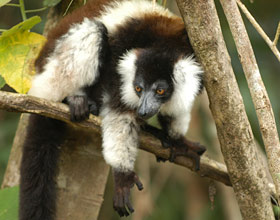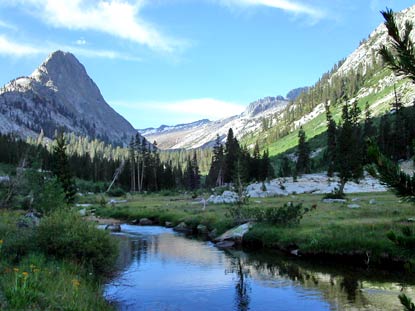 By sampling animal populations, scientists suggest that we may have entered the next wave of extinction, called the Pleistocene-Holocene extinction.
By sampling animal populations, scientists suggest that we may have entered the next wave of extinction, called the Pleistocene-Holocene extinction.And this time, the cause isn't an errant asteroid or mega-volcanoes. It's us. According to the World Wildlife Fund, humans have altered the Earth’s ecosystems more rapidly and extensively in the past 50 years than any other period in human history. Such changes have already degraded more than half of the ecosystems on which we depend on for everything from food to building materials, and caused the permanent loss of many habitats and species. We are already using nearly 30 percent more natural resources than the Earth can replenish.
Through the increasing human population, human activities such as deforestation, illegal wildlife trade and poaching, we're shaping an Earth that will be biologically impoverished. A 2008 assessment by the International Union for Conservation of Nature found that nearly 1 in 4 mammals worldwide were at risk for extinction, including endangered species such as the Sumatran Tiger and Javan Rhinoceros. Even marine diversity is threatened by overfishing and the acidification of oceans. We have turned a blind eye long enough to allow such a dire situation to occur, as humans we must do more— much more— to ensure that our planet will thrive for future generations.
The steady rise in human population is crowding out other species by sheer number. The current world population of 6.7 billion is expected to balloon to 9 billion by 2050. Sustained growth in India over the next 20 years is expected to lead to reduced poverty and the emergence of a half-a-billion-strong middle-class. This would increase India’s consumption by four fold, making it the fifth largest consumer market in the world by 2025. This number of people cannot help but leave a sizable footprint on the landscape. The people would want new and better homes and land would have to be cleared to make room for those homes, leaving less and less space for wildlife.
 The rapid rate of deforestation is destroying the habitats of countless numbers of species. Tropical forests are home to the greatest concentration of biodiversity on the planet. From 1990 to 2005, the world lost 172 million acres of forest— much of it in South American countries like Brazil, where deforestation has accelerated as land is cleared for pastures, infrastructure improvements, commercial agriculture, and logging. About 15 percent of the Amazon’s total area has been cleared sine 1970, excluding areas degraded by fires and selective logging.
The rapid rate of deforestation is destroying the habitats of countless numbers of species. Tropical forests are home to the greatest concentration of biodiversity on the planet. From 1990 to 2005, the world lost 172 million acres of forest— much of it in South American countries like Brazil, where deforestation has accelerated as land is cleared for pastures, infrastructure improvements, commercial agriculture, and logging. About 15 percent of the Amazon’s total area has been cleared sine 1970, excluding areas degraded by fires and selective logging.The trade in endangered wild animals—as pets, performers, food, medicine, and more— is a new and growing menace to wildlife. Total wildlife trade is believed to be the second largest direct threat to many species, after habitat loss. This has become so severe that conservationists have coined the term empty-forest syndrome to describe habitats that remain in-tact but have been stripped of the animals that had once lived there. Southeast Asian countries such as Bangkok and Guangzhou have long been hubs of illegal wildlife trade. The live markets there sell anything from live primates and turtles to tiger claws and their various body parts. According to the World Wildlife Fund, the international trade of wildlife species is worth an estimated US$20 billion. The high demand and value of animal parts make killing even more profitable. According to the Nepali Times, each kilogram of rhinoceros horn can fetch up to US$10,000 while one bowl of tiger penis soup can command over US$300.
 Increasing and unsustainable rates of poaching— the illegal hunting, killing, or capturing of animals—have caused species such as the African elephant dwindle by 8 percent each year. If this trend continues, the African elephant would be extinct by 2020. In the Congo Basin in Central Africa, three-fifths of all large mammals are being hunted at unsustainable rates. Commercial bushmeat hunters use more efficient killing machines such as shotguns and snares, rather than traditional spears and nets, to bring lucrative bushmeat to growing markets in African villages and cities. The loss of wildlife threatens the livelihoods and food security of indigenous and rural populations that depend on wildlife as a staple or supplement to their diet. In the Congo Basin alone, bushmeat is hunted at more than six times the maximum sustainable rate each year, according to the Wildlife Conservation Society.
Increasing and unsustainable rates of poaching— the illegal hunting, killing, or capturing of animals—have caused species such as the African elephant dwindle by 8 percent each year. If this trend continues, the African elephant would be extinct by 2020. In the Congo Basin in Central Africa, three-fifths of all large mammals are being hunted at unsustainable rates. Commercial bushmeat hunters use more efficient killing machines such as shotguns and snares, rather than traditional spears and nets, to bring lucrative bushmeat to growing markets in African villages and cities. The loss of wildlife threatens the livelihoods and food security of indigenous and rural populations that depend on wildlife as a staple or supplement to their diet. In the Congo Basin alone, bushmeat is hunted at more than six times the maximum sustainable rate each year, according to the Wildlife Conservation Society. Many species that have lived before are now extinct. Evolution demands extinction. So why should the loss of a few species among millions matter to us? Are species such as the Holdrige’s toad, Yangtze River Dolphin and the golden toad—all of which have disappeared within recent years—really that important?
Many species that have lived before are now extinct. Evolution demands extinction. So why should the loss of a few species among millions matter to us? Are species such as the Holdrige’s toad, Yangtze River Dolphin and the golden toad—all of which have disappeared within recent years—really that important?  The answer is “yes”. Like every other form of life, we are animals dependent on this planet, too. The more diverse the animals in an ecosystem, the healthier and more productive it is— which is good for us. A recent study by the World Wildlife Fund estimates the economic value of the Amazon rain forest's ecosystem services to be up to US$100 per hectare. Moreover, there could be animals and organisms of medicinal value that have yet to be discovered. For example, the herb meadowseed was originally used in aspirin, and the Chinese use porcupine extracts as an effective cure for dengue fever.
The answer is “yes”. Like every other form of life, we are animals dependent on this planet, too. The more diverse the animals in an ecosystem, the healthier and more productive it is— which is good for us. A recent study by the World Wildlife Fund estimates the economic value of the Amazon rain forest's ecosystem services to be up to US$100 per hectare. Moreover, there could be animals and organisms of medicinal value that have yet to be discovered. For example, the herb meadowseed was originally used in aspirin, and the Chinese use porcupine extracts as an effective cure for dengue fever.Extinction is forever. It cannot be reversed. Forests burned can grow back and polluted air and water can be cleaned—but extinction is permanent. It is not just a few species that are at risk of extinction— we are talking about hundreds of thousands to millions of species that could possibly disappear. Many of these species have not even been discovered yet. We could doom ourselves to what naturalist E.O. Wilson calls the Eremozoic Era— the Age of Loneliness. Fortunately, there are methods that address this issue of extinction.
Environmental groups around the world are coming up with new ways to protect threatened wildlife. In conservation hot spots like Madagascar and Brazil, conservationists are working with locals to ensure that the protection of endangered species are linked with the welfare of people who live close to them. Avoided deforestation provides an incentive for environmental protection by putting a value on the carbon that is contained in the trees of a forest. Countries can then trade in these carbon credits, provided that those trees are not cut or burned. This could potentially mean billions of dollars for developing countries. In 1997, the American nonprofit the Nature Conservancy, American utility companies such as American Electric Power and PacifiCorp, and oil major BP Amoco paid Bolivia US$10.8 million for the credits represented by all the carbon in the Noel Kempff Mercado National Park.
 Global warming forces animals to migrate to escape changing climates, and sometimes these animals wander right into areas of degraded land. To connect fragmented habitats caused by the effects of climate change, conservation corridors are designed to allow natural movement for wildlife. In India, a corridor 37 miles long and 6 miles wide connects important tiger habitats in the Eastern Himalaya and the Western Ghats mountain ranges.
Global warming forces animals to migrate to escape changing climates, and sometimes these animals wander right into areas of degraded land. To connect fragmented habitats caused by the effects of climate change, conservation corridors are designed to allow natural movement for wildlife. In India, a corridor 37 miles long and 6 miles wide connects important tiger habitats in the Eastern Himalaya and the Western Ghats mountain ranges. Ecotourism is another method that provides support for conservationism. According to the International Ecotourism Society, ecotourism is responsible travel to natural areas that conserves the environment and improves the natural wellbeing of local people. It minimizes impact on the environment while building environmental awareness and providing financial benefits both for conservation and the local people. When it was discovered that tourism has become a major threat in Bolivia’s Eduardo Avaroa Reserve, the Nature Conservancy along with the Bolivian National Park System implemented a park entrance fee concept. This program has generated over US$500,000 in new funds,which were used to address tourism-related threats. It is estimated that the national protected areas system could generate more than US$3 million per year in new income for conservation.
 According to Times Magazine, in the United States, a newly signed omnibus bill will protect some 2 million acres of wilderness⎯ the most significant conservation effort in more than a decade. The Sequioia and Kings Canyon National Parks Wilderness and Wild Monongahela Wilderness are some of the areas affected by the bill. The legislation also protects 1,000 miles of scenic rivers and provides more federal protection to aread under the Bureau of Land Management.
According to Times Magazine, in the United States, a newly signed omnibus bill will protect some 2 million acres of wilderness⎯ the most significant conservation effort in more than a decade. The Sequioia and Kings Canyon National Parks Wilderness and Wild Monongahela Wilderness are some of the areas affected by the bill. The legislation also protects 1,000 miles of scenic rivers and provides more federal protection to aread under the Bureau of Land Management. It is uncertain that these efforts will prevent the next wave of extinction, but it's worth a try.
It is uncertain that these efforts will prevent the next wave of extinction, but it's worth a try.In a world where billions of people are starving and where the global economic crisis has people struggling to make ends meet, it's easy not to be concerned about Earth's diminishing biodiversity. But this planet is all we have. All that sustains wildlife— the clean water, unblemished land and lush forests— ultimately sustains us as well. We were the cause of the animals' plights, but we are also the solution.
The current efforts discussed are just the tip of the iceberg. There is much, much more that needs to be done. New laws and regulations need to be enacted and enforced. But most of all, people's mindsets must change— they must realize that their actions today would significantly impact the livelihood of this planet in future. We must save this planet not only for ourselves and the animals, but for our children and their children. As the indigenous proverb goes— We don’t inherit the planet from our parents; we borrow it from our children.




No comments:
Post a Comment